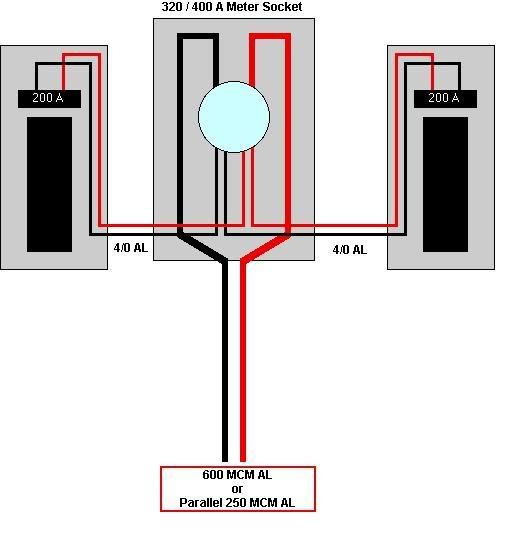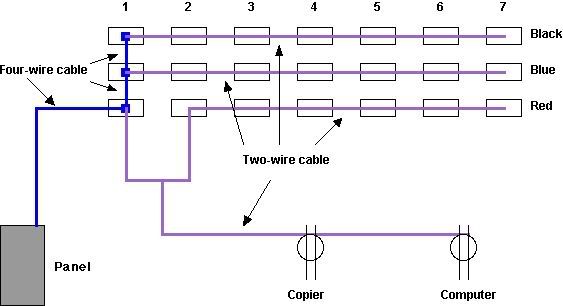Docluv said:
I am confused about how the wire between the meter and the disconects are protected? Is it realy just the two 200amp disconects? why wouldn't the disconects burn up?
If they have overcurrent protection in them, why would they? When they exceed 200A they shut off, either by breaker or by fuse.
These are fused disconnects, aren't they?
Am I too understand that by putting nuckle splices on the wire lowers the amps?
No, the current (amps) is determined by the load.
Why is it that when I split a 15amp branch circuit with a wire nut and pigtails, my pigtails both read 15amps?
If that's so, you've clamped to a point on the circuit before the two wires split to their different loads. Check out this diagram:
From this panel is a four-wire cable: 3 hots, 1 neutral.
At the panel, with an amp-clamp, the Black load is 7A, Red load is 7A, Blue load is 7A. Each fluorescent light draws one amp. Between Black #7 and Black #6, those conductors are experiencing one amp of current. Between #6 and #5, those conductors are seeing two amps, and so forth.
If you slap an amp-clamp between on the black between #5 and #4, the amp clamp will read 3A.
So, by comparison, if you have two panels with loads, the conductors feeding each panel are only carrying the amps that are depending on those conductors to work. Essentially, the home run in the diagram is the same as the 400A conductors in your service: If, after they branch off, the branches are protected at 200A and the trunk is worth 400A, the branches can't damage the trunk.
-------------------------------------------------------------
I think another key to understand is a fundamental that Bob touched on in a
recent thread.
A 400A meter socket is good for a continuous load of 320A.
A 400A breaker is good for a continuous load of 320A.
This "325A meter socket" is not manufactured, to my knowledge. What you probably have is a 400A (320 continuous) meter socket. Which means, so far, you have a 400A service.
A service is a service - if you think about it, all service conductors are protected on their
load side, unlike everything else that we protect on the line side. We have no way to protect service conductors on the line side, they're inaccessible to us (and the NEC).
So, we protect them in a less complete fashion, on their load side.
Since service conductors are essentially unprotected, this is why we are required to keep them almost entirely outside. All service conductors are unsafe.
If you install 400A conductors, and then downsize into two 200A panels, then you will have basically two 200A services.
Functionally, when each panel is drawing 200A, then every point along the service conductors are protected to their ampacity. If panel A pulls 230, and so does panel B, then we have 460A total; but each breaker on each panel will trip, so the big conductors will not see any more current than the smaller ones, proportionally. All conductors can withstand some overloading prior to their OCPD tripping.



